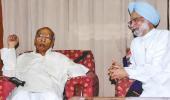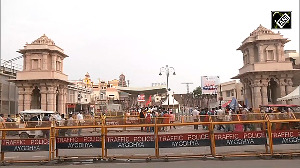India needs another shot of difficult reform, of the kind only possible at gunpoint.
Mr Trump holds that gun to our heads now.
A drastic reduction in tariff protection, other elements of sarkari wet-nursing will force entrepreneurial India to become competitive again, argues Shekhar Gupta.

Is the arrival of Donald Trump and the breathless rise of Trumpism a good or a bad thing for India?
His song from the day he moved into the White House has been, 'Everybody has robbed us, friend or foe'.
Since then, he's been relentlessly targeting friends first -- Europe on strategic and defence issues, Canada, Mexico and, of course, India, "the tariff king," on trade.
Here's my short answer: This change in Washington is like a gun held to India's head, with Mr Trump's finger on the trigger.
It is also the best thing that could happen to India. Sounds nutty?
Please indulge me for a few minutes as I make my case.
As with any nation-State of some size, and even more so for a democracy, politics, and economics go hand in hand.
In normal times, political leadership should determine the direction of a nation's economy. In India, that 'normal' has had indifferent results most of the time.
The two moments when India carried out substantive reforms, it had a gun held to its head.
The first, with the balance of payments crisis (often misstated as bankruptcy) and the need to go to the IMF in 1991, and then, during the global sanctions after Pokhran-2 in 1998.
Mr Trump threatening to pull the trigger will be the third.
It is just what was needed to wake up India's self-congratulatory establishment from its headline-managing fantasies.
It's one thing to serve your domestic audience with the usual headline management -- slogans like 'fastest growing major economy', or 'the fifth-largest and soon to be the third, leaving Japan and Germany behind' -- and a manufacturing revolution that we've been told has been coming for the past decade but hasn't yet arrived.
Is this Trump push to the trigger needed? We can learn by looking back a bit.

Let's simply write off 1947 to 1989 as an economic nightmare.
Some historians and economists might argue that Indira Gandhi, in her post-Emergency avatar, had started loosening controls, and Rajiv Gandhi carried on.
The idea that they began reforming the economy will convince no one except the deep, old Congress partisan.
If India's economic evolution -- and its first revolution -- owes anything to that Indira-Rajiv decade, it is the balance of payments crisis that gifted India its first sweeping reform.
P Chidambaram as finance minister made some significant changes in the 1997-1998 (Deve Gowda-Gujral) era.
Most were incremental to the Rao-Manmohan reform, but a most significant move that opened the door for the stock market listing of PSUs and ultimately privatisation also came in this period.
This done, India had to wait for its next gun-to-the-head moment, Vajpayee government's Pokhran-2 tests in 1998, and the avalanche of sanctions and rebuke from the US and its allies, from Europe to Japan and Australia.
As Jaswant Singh initiated his dialogue with the Americans (check both his account and that of his American interlocutor Strobe Talbott), the biggest pitch he made, India being a responsible nuclear power and counterweight to China, was to ask if US could afford to miss the massive economic opportunity of a reforming India?
This sparked our second wave of reforms, including large-scale privatisation of PSUs, even profit-making ones.
Looking back today, it feels like a brief dream our generation had the joy of living.
Since then, there's been nothing but Air India.
Post-Pokhran sanctions, reforms ranged from FDI to imports, freedom for Indian businesses to invest overseas, and the privilege for ordinary citizens to spend or invest $250,000 overseas each financial year under the Liberalised Remittance Scheme (LRS) and indeed, reduction in tariffs.
Finance Minister Yashwant Sinha said in his 1999 Budget that he had brought tariffs almost to ASEAN levels. In the UPA decade, none of these reforms was reversed, except for a block on PSU privatisation.

The first pushback the Rao-Manmohan reform encountered wasn't so much from the entrenched socialists in the Congress, but from the captains of corporate India.
The late Rahul Bajaj rallied together the heavyweights under his so-called Bombay Club.
Their argument to stall and postpone reforms mirrored that of any other incumbent lobby: This is too early to expose us to competition. In fact, protect and strengthen us until we can compete. Then you reform.
It is to Rao's credit that he didn't wilt, even though he ran a minority government and the Bombay Club had many supporters -- some acting as guns-on-retainer within the Congress.
But it was also because he could flaunt the compulsion of that IMF loan and the disaster that would follow if India defaulted.
The result was a spectacular creative destruction in corporate India.
Of the 1991 equivalent of today's 30 Sensex companies or leading lights of corporate India, about 12 have completely disappeared.
Many receded into insignificance.
Think Hindustan Motors, Premier Automobiles, Orkay, Escorts.
Those that embraced reform boomed -- Tata, Mahindra, and, for heaven's sake, Bajaj.
New stars emerged: ICICI and HDFC, Bharti, Infosys and Wipro.
This creative destruction is the essence of capitalism, a point Sanjeev Sanyal, member of the Prime Minister-Economic Advisory Council, made in an article, lamenting the fact that this process has mostly ceased in the past decade. Indian companies have become smug.
So how did we get here? The Modi majority of 2014 was seen by corporate India, especially the oligarchs, to mean that the good old times, of an all-powerful mai-baap government under whose chhatrachhaya (protective umbrella) they could prosper was back.
Since then, we have seen the return of higher tariffs.
A small example: You might be buying in India the most expensive steel in the world.
Any surprise then that the steel maker with the largest market cap in the world is Indian?
Even the biggest Chinese firms, that produce enormously more steel, are valued lower.
That the pre-reform distortions are back is evident.
With increasingly powerful oligarchs dividing up the market share and sectors and government lapsing into that oldest belief -- that growth can be driven top-down. Has it worked?
The government's own data (MoSPI) shows that after 10 years of Make in India, the share of manufacturing in India's GDP in 2023-24 was exactly the same as in 2013-2014.
To the last decimal point: 17.3 per cent. This year, it is trending to be even lower, with manufacturing trailing even agriculture in Q3.
More reality check: The contribution of manufacturing to job creation was marginally lower at 10.6 per cent in 2022-23, compared to 11.6 per cent in 2013-14.
This is from RBI's KLEMS database. While we celebrate the genuine success in smartphone manufacture, the share of exports in our GDP has fallen from 25 per cent in 2013-14 to 22.7 per cent now (Economic Survey, 2023-24).
The Survey also tells us that, accordingly, the growth rate of India's share of global exports has also slowed.
The touching idea that state-patronage will usher India into a manufacturing and exporting utopia has bombed.
Indian corporations aren't investing, despite the finance minister's repeated admonitions, because they see inadequate demand.
And they're too pampered to compete for exports. They're petrified that India is about to let the Chinese make cars and more in India.

India needs another shot of difficult reform, of the kind only possible at gunpoint. Mr Trump holds that gun to our heads now.
A drastic reduction in tariff protection, other elements of sarkari wet-nursing will force entrepreneurial India to become competitive again.
If some companies die, celebrate the creative destruction of capitalism.
Out of this manthan will emerge battle-hardened survivors and new stars of India's future.
By special arrangement with The Print
Feature Presentation: Aslam Hunani/Rediff.com












 © 2025
© 2025